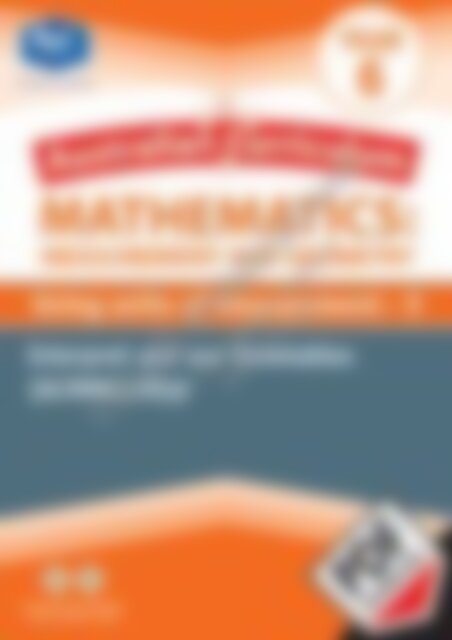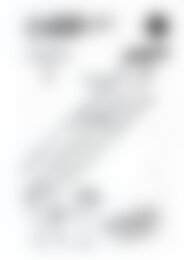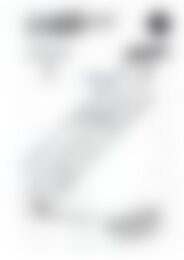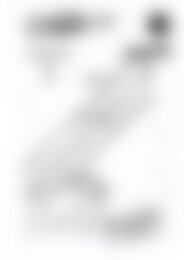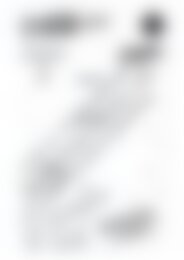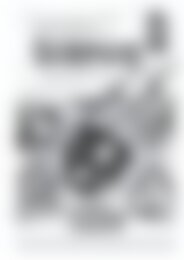RIC-20175 ACM Measurement and Geometry (Yr 6) Using units of measurement 5
Create successful ePaper yourself
Turn your PDF publications into a flip-book with our unique Google optimized e-Paper software.
©R.I.C. Publications<br />
Low Resolution Images<br />
Display Copy
Australian Curriculum Mathematics<br />
resource book: <strong>Measurement</strong> <strong>and</strong> <strong>Geometry</strong><br />
(Year 6)<br />
Published by R.I.C. Publications ® 2013<br />
Copyright © Linda Marshall 2013<br />
<strong>RIC</strong>– <strong>20175</strong><br />
Titles in this series:<br />
Australian Curriculum Mathematics resource book:<br />
<strong>Measurement</strong> <strong>and</strong> <strong>Geometry</strong> (Foundation)<br />
Australian Curriculum Mathematics resource book:<br />
<strong>Measurement</strong> <strong>and</strong> <strong>Geometry</strong> (Year 1)<br />
Australian Curriculum Mathematics resource book:<br />
<strong>Measurement</strong> <strong>and</strong> <strong>Geometry</strong> (Year 2)<br />
Australian Curriculum Mathematics resource book:<br />
<strong>Measurement</strong> <strong>and</strong> <strong>Geometry</strong> (Year 3)<br />
Australian Curriculum Mathematics resource book:<br />
<strong>Measurement</strong> <strong>and</strong> <strong>Geometry</strong> (Year 4)<br />
Australian Curriculum Mathematics resource book:<br />
<strong>Measurement</strong> <strong>and</strong> <strong>Geometry</strong> (Year 5)<br />
Australian Curriculum Mathematics resource book:<br />
<strong>Measurement</strong> <strong>and</strong> <strong>Geometry</strong> (Year 6)<br />
All material identified by is material subject to<br />
copyright under the Copyright Act 1968 (Cth) <strong>and</strong> is owned<br />
by the Australian Curriculum, Assessment <strong>and</strong> Reporting<br />
Authority 2013.<br />
For all Australian Curriculum material except<br />
elaborations: This is an extract from the Australian<br />
Curriculum.<br />
Elaborations: This may be a modified extract from the<br />
Australian Curriculum <strong>and</strong> may include the work <strong>of</strong> other<br />
authors.<br />
Disclaimer: ACARA neither endorses nor verifies the<br />
accuracy <strong>of</strong> the information provided <strong>and</strong> accepts no<br />
responsibility for incomplete or inaccurate information. In<br />
particular, ACARA does not endorse or verify that:<br />
• The content descriptions are solely for a particular year<br />
<strong>and</strong> subject;<br />
• All the content descriptions for that year <strong>and</strong> subject<br />
have been used; <strong>and</strong><br />
• The author’s material aligns with the Australian<br />
Curriculum content descriptions for the relevant year <strong>and</strong><br />
subject.<br />
You can find the unaltered <strong>and</strong> most up to date version <strong>of</strong><br />
this material at http://www.australiancurriculum.edu.au/<br />
This material is reproduced with the permission <strong>of</strong> ACARA.<br />
Copyright Notice<br />
A number <strong>of</strong> pages in this book are worksheets.<br />
The publisher licenses the individual teacher who<br />
purchased this book to photocopy these pages to h<strong>and</strong><br />
out to students in their own classes.<br />
Except as allowed under the Copyright Act 1968, any<br />
other use (including digital <strong>and</strong> online uses <strong>and</strong> the<br />
creation <strong>of</strong> overhead transparencies or posters) or any<br />
use by or for other people (including by or for other<br />
teachers, students or institutions) is prohibited. If you<br />
want a licence to do anything outside the scope <strong>of</strong> the<br />
BLM licence above, please contact the Publisher.<br />
This information is provided to clarify the limits <strong>of</strong> this<br />
licence <strong>and</strong> its interaction with the Copyright Act.<br />
For your added protection in the case <strong>of</strong> copyright<br />
inspection, please complete the form below. Retain this<br />
form, the complete original document <strong>and</strong> the invoice<br />
or receipt as pro<strong>of</strong> <strong>of</strong> purchase.<br />
Name <strong>of</strong> Purchaser:<br />
Date <strong>of</strong> Purchase:<br />
Supplier:<br />
School Order# (if applicable):<br />
Signature <strong>of</strong> Purchaser:<br />
©R.I.C. Publications<br />
Low Resolution Images<br />
Display Copy<br />
Internet websites<br />
In some cases, websites or specific URLs may be recommended. While these are checked <strong>and</strong> rechecked at the time <strong>of</strong> publication,<br />
the publisher has no control over any subsequent changes which may be made to webpages. It is strongly recommended that the class<br />
teacher checks all URLs before allowing students to access them.<br />
View all pages online<br />
PO Box 332 Greenwood Western Australia 6924<br />
Website: www.ricpublications.com.au<br />
Email: mail@ricgroup.com.au
Foreword<br />
AUSTRALIAN CUR<strong>RIC</strong>ULUM MATHEMATICS<br />
RESOURCE BOOK:<br />
MEASUREMENT AND GEOMETRY<br />
(YEAR 6)<br />
Australian Curriculum Mathematics resource book: <strong>Measurement</strong> <strong>and</strong> <strong>Geometry</strong> (Year 6) is one in a series <strong>of</strong> seven teacher resource books that support<br />
teaching <strong>and</strong> learning activities in Australian Curriculum Mathematics. The books focus on the <strong>measurement</strong> <strong>and</strong> geometry content str<strong>and</strong>s <strong>of</strong> the<br />
national maths curriculum. The resource books include theoretical background information, Resource sheets, h<strong>and</strong>s-on activities <strong>and</strong> assessment<br />
activities, along with links to other curriculum areas.<br />
Format <strong>of</strong> this book ....................................................................... iv – v<br />
<strong>Using</strong> <strong>units</strong> <strong>of</strong> <strong>measurement</strong> .................................................... 2–61<br />
• UUM – 1<br />
Connect decimal representations to the metric system (<strong>ACM</strong>MG135)<br />
– Teacher information ................................................................................. 2<br />
– H<strong>and</strong>s-on activities ................................................................................... 3<br />
– Links to other curriculum areas ................................................................. 3<br />
– Resource sheets .................................................................................... 4–6<br />
– Assessment .......................................................................................... 7–8<br />
– Checklist ................................................................................................... 9<br />
• UUM – 2<br />
Convert between common metric <strong>units</strong> <strong>of</strong> length, mass <strong>and</strong><br />
capacity. (<strong>ACM</strong>MG136)<br />
– Teacher information ......................................................................... 10–13<br />
– H<strong>and</strong>s-on activities ........................................................................... 14–16<br />
– Links to other curriculum areas ................................................................ 16<br />
– Resource sheets ................................................................................ 17–25<br />
– Assessment ...................................................................................... 26–28<br />
– Checklist .................................................................................................. 29<br />
• UUM – 3<br />
Solve problems involving the comparison <strong>of</strong> lengths <strong>and</strong> areas<br />
using appropriate <strong>units</strong> (<strong>ACM</strong>MG137)<br />
– Teacher information ................................................................................ 30<br />
– H<strong>and</strong>s-on activities .................................................................................. 31<br />
– Links to other curriculum areas ................................................................ 32<br />
– Resource sheets ................................................................................ 33–36<br />
– Assessment ...................................................................................... 37–38<br />
– Checklist .................................................................................................. 39<br />
• UUM – 4<br />
Connect volume <strong>and</strong> capacity <strong>and</strong> their <strong>units</strong> <strong>of</strong><br />
<strong>measurement</strong> (<strong>ACM</strong>MG138)<br />
– Teacher information ......................................................................... 40–41<br />
– H<strong>and</strong>s-on activities .................................................................................. 42<br />
– Links to other curriculum areas ................................................................ 43<br />
– Resource sheets ................................................................................ 44–45<br />
– Assessment ............................................................................................. 46<br />
– Checklist .................................................................................................. 47<br />
• UUM – 5<br />
Interpret <strong>and</strong> use timetables (<strong>ACM</strong>MG139)<br />
– Teacher information ......................................................................... 48–49<br />
– H<strong>and</strong>s-on activities .................................................................................. 50<br />
– Links to other curriculum areas ................................................................ 51<br />
– Resource sheets ................................................................................ 52–55<br />
– Assessment ............................................................................................. 56<br />
– Checklist .................................................................................................. 57<br />
Contents<br />
Answers ............................................................................................ 58–61<br />
Shape .................................................................................................. 62–79<br />
• Shape – 1<br />
Construct simple prisms <strong>and</strong> pyramids (<strong>ACM</strong>MG140)<br />
– Teacher information ......................................................................... 62–63<br />
– H<strong>and</strong>s-on activities ........................................................................... 64–65<br />
– Links to other curriculum areas ................................................................ 65<br />
– Resource sheets ................................................................................ 66–75<br />
– Assessment ...................................................................................... 76–77<br />
– Checklist .................................................................................................. 78<br />
Answers .................................................................................................... 79<br />
Location <strong>and</strong> transformation .............................................. 80–113<br />
• L&T – 1<br />
Investigate combinations <strong>of</strong> translations, refl ections <strong>and</strong> rotations,<br />
with <strong>and</strong> without the use <strong>of</strong> digital technologies (<strong>ACM</strong>MG142)<br />
– Teacher information ......................................................................... 80–81<br />
– H<strong>and</strong>s-on activities .................................................................................. 82<br />
– Links to other curriculum areas ................................................................ 83<br />
– Resource sheets ................................................................................ 84–94<br />
– Assessment ...................................................................................... 95–96<br />
– Checklist .................................................................................................. 97<br />
• L&T – 2<br />
Introduce the Cartesian coordinate system using all four<br />
quadrants (<strong>ACM</strong>MG143)<br />
©R.I.C. Publications<br />
Low Resolution Images<br />
Display Copy<br />
–<br />
–<br />
–<br />
–<br />
–<br />
–<br />
Teacher information ......................................................................... 98–99<br />
H<strong>and</strong>s-on activities ................................................................................ 100<br />
Links to other curriculum areas .............................................................. 101<br />
Resource sheets ............................................................................ 102–108<br />
Assessment .................................................................................. 109–110<br />
Checklist ................................................................................................ 111<br />
Answers ...................................................................... 112–113<br />
Geometric reasoning ............................................................ 114–131<br />
• GR – 1<br />
Investigate, with <strong>and</strong> without digital technologies, angles on a<br />
straight line, angles at a point <strong>and</strong> vertically opposite angles. Use<br />
results to fi nd unknown angles (<strong>ACM</strong>MG141)<br />
– Teacher information ..................................................................... 114–115<br />
– H<strong>and</strong>s-on activities ................................................................................ 116<br />
– Links to other curriculum areas .............................................................. 117<br />
– Resource sheets ............................................................................ 118–127<br />
– Assessment ...................................................................................128–129<br />
– Checklist ................................................................................................ 130<br />
Answers ................................................................................................. 131<br />
Australian Curriculum Mathematics resource book: <strong>Measurement</strong> <strong>and</strong> <strong>Geometry</strong> (Year 6) R.I.C. Publications ® www.ricpublications.com.au iii
FORMAT OF THIS BOOK<br />
This teacher resource book includes supporting materials for teaching <strong>and</strong> learning in all sections <strong>of</strong> the <strong>Measurement</strong> <strong>and</strong> <strong>Geometry</strong> content str<strong>and</strong> <strong>of</strong><br />
Australian Curriculum Mathematics. It includes activities relating to all sub-str<strong>and</strong>s: <strong>Using</strong> <strong>units</strong> <strong>of</strong> <strong>measurement</strong>, Shape, Location <strong>and</strong> transformation,<br />
<strong>and</strong> Geometric reasoning. All content descriptions have been included, as well as teaching points based on the curriculum’s elaborations. Links to the<br />
pr<strong>of</strong>iciency str<strong>and</strong>s have also been included.<br />
Each section supports a specific content description <strong>and</strong> follows a consistent format, containing the following information over several pages:<br />
• teacher information with related terms, student vocabulary, what the content description means, teaching points <strong>and</strong> problems to watch for<br />
• h<strong>and</strong>s-on activities<br />
• resource sheets<br />
• a checklist<br />
• links to other curriculum areas<br />
• assessment sheets.<br />
Answers relating to the assessment pages are included on the final page <strong>of</strong> the section for each sub-str<strong>and</strong> (<strong>Using</strong> <strong>units</strong> <strong>of</strong> <strong>measurement</strong>, Shape,<br />
Location <strong>and</strong> transformation, <strong>and</strong> Geometric reasoning).<br />
The length <strong>of</strong> each content description section varies.<br />
Related terms includes vocabulary associated<br />
with the content description. Many <strong>of</strong> these<br />
relate to the glossary in the back <strong>of</strong> the <strong>of</strong>ficial<br />
Australian Curriculum Mathematics document;<br />
additional related terms may also have been<br />
added.<br />
Student vocabulary includes words which<br />
the teacher would use—<strong>and</strong> expect the<br />
students to learn, underst<strong>and</strong> <strong>and</strong> use—during<br />
mathematics lessons.<br />
The pr<strong>of</strong>iciency str<strong>and</strong>(s) (Underst<strong>and</strong>ing,<br />
Fluency, Problem Solving solving or Reasoning) relevant<br />
to each content description are listed. shown in bold.<br />
Teacher information includes background information relating to the content description, as well as<br />
related terms, desirable student vocabulary <strong>and</strong> other useful details which may assist the teacher.<br />
What this means provides<br />
a general explanation <strong>of</strong> the<br />
content description.<br />
Teaching points provides<br />
a list <strong>of</strong> the main teaching<br />
points relating to the content<br />
description.<br />
What to watch look for for suggests any any<br />
difficulties <strong>and</strong> misconceptions<br />
the students might encounter or<br />
develop.<br />
©R.I.C. Publications<br />
Low Resolution Images<br />
Display Copy<br />
H<strong>and</strong>s-on activities includes descriptions or<br />
instructions for games or activities relating to the<br />
content descriptions or elaborations. Some <strong>of</strong> the<br />
h<strong>and</strong>s-on activities are supported by Resource resource<br />
sheets. Where applicable, these will be stated for<br />
easy reference.<br />
iv Australian Curriculum Mathematics resource book: <strong>Measurement</strong> <strong>and</strong> <strong>Geometry</strong> (Year 6) R.I.C. Publications ® www.ricpublications.com.au
FORMAT OF THIS BOOK<br />
Links to other curriculum areas includes activities in other curriculum areas which support<br />
the content description. These include Information <strong>and</strong> Communication Technology, English,<br />
Science, Languages other than English, History, Geography <strong>and</strong> the Arts. This section may list<br />
many links or only a few. It may also provide links to relevant interactive websites appropriate<br />
for the age group.<br />
Cross-curricular links reinforce the knowledge that mathematics can be found within, <strong>and</strong> relate<br />
to, many other aspects <strong>of</strong> student learning <strong>and</strong> everyday life.<br />
Resource sheets are provided to support<br />
teaching <strong>and</strong> learning activities for each<br />
content description. The resource sheets<br />
could be cards for games, charts, additional<br />
worksheets for class use or other materials<br />
which the teacher might find useful to use or<br />
display in the classroom. For each resource<br />
sheet, the content description to which it<br />
relates is given.<br />
Assessment pages are included. Support<br />
activities are in the h<strong>and</strong>s-on activities or<br />
resource sheets.<br />
©R.I.C. Publications<br />
Low Resolution Images<br />
Display Copy<br />
Each section has a checklist which teachers<br />
may find useful as a place to keep a record <strong>of</strong><br />
the results <strong>of</strong> assessment activities, or their<br />
observations <strong>of</strong> h<strong>and</strong>s-on activities.<br />
Answers for resource sheets (where<br />
appropriate) <strong>and</strong> assessment pages are<br />
provided on the final page <strong>of</strong> each sub-str<strong>and</strong><br />
section.<br />
Australian Curriculum Mathematics resource book: <strong>Measurement</strong> <strong>and</strong> <strong>Geometry</strong> (Year 6) R.I.C. Publications ® www.ricpublications.com.au v
Sub-str<strong>and</strong>: <strong>Using</strong> <strong>units</strong> <strong>of</strong> <strong>measurement</strong>—UUM – 5<br />
Interpret <strong>and</strong> use timetables (<strong>ACM</strong>MG139)<br />
RELATED TERMS<br />
TEACHER INFORMATION<br />
am (ante meridiem)<br />
• From the Latin words meaning<br />
before noon.<br />
pm (post meridiem)<br />
• From the Latin words meaning<br />
after noon.<br />
Conversions <strong>of</strong> time<br />
60 seconds = 1 minute<br />
60 minutes = 1 hour<br />
24 hours = I day<br />
Expressing two <strong>units</strong><br />
• For example, 1 day <strong>and</strong> 4 hours as<br />
28 hours or 2 hours <strong>and</strong> 40 minutes<br />
as 160 minutes.<br />
Student vocabulary<br />
o’clock<br />
half past<br />
quarter past<br />
quarter to<br />
xx:25 (eg 3:25)<br />
xx:52 (eg 3:52)<br />
clockwise<br />
What this means<br />
• It is important for students to become familiar with a variety <strong>of</strong><br />
timetable formats. The 12-hour <strong>and</strong> 24-hour formats are most<br />
commonly used.<br />
• It is expected that students can tell the time to the nearest minute<br />
using both 12- <strong>and</strong> 24-hour clocks.<br />
• Converting between 12- <strong>and</strong> 24-hour times can be difficult because <strong>of</strong><br />
the non-metric nature <strong>of</strong> time. So 1630 is not 6:30 pm, but 4:30 pm.<br />
• Calculations <strong>of</strong> time difference can be quite difficult, again because <strong>of</strong><br />
the non-decimal nature <strong>of</strong> time. For example, if using a timetable <strong>and</strong><br />
calculating how long before the next bus, a calculator may actually<br />
hamper the process. If the bus arrives at 1625 <strong>and</strong> it is currently 1547,<br />
you cannot simply key 1625 into a calculator <strong>and</strong> subtract 1527; the<br />
result would be 78, which a child could incorrectly interpret as 78<br />
minutes. In this case, the number <strong>of</strong> minutes until 1600 would be<br />
calculated first (13 minutes), <strong>and</strong> the extra 25 minutes until the desired<br />
time (1625) added to give a total waiting time <strong>of</strong> 38 minutes.<br />
Teaching points<br />
• St<strong>and</strong>ard abbreviations for <strong>units</strong> for time are seconds (s), minutes (min)<br />
<strong>and</strong> hours (h); the other <strong>units</strong> do not have st<strong>and</strong>ard abbreviations.<br />
Note: ‘sec’ <strong>and</strong> ‘hr’ are commonly used abbreviations for second <strong>and</strong><br />
hour, but they are not the correct ones.<br />
• When writing 12-hour time, we use a colon between the hours <strong>and</strong><br />
minutes; for example, two o’clock should be 2:00 not 2.00. When<br />
writing 24-hour time we generally do not use a colon, but use 4 digits;<br />
for example, 4:33 pm would be written as 1633. For times before<br />
10 am, there is a zero at the start in 24-hour time; e.g. 0730 for 7:30<br />
in the morning. Whether we say ‘oh’ or ‘zero’ depends on community<br />
practice, but it should always be in the written form. (Note: some<br />
sources do use a colon in 24-hour time.)<br />
©R.I.C. Publications<br />
Low Resolution Images<br />
Display Copy<br />
• Telling the time in both 12- <strong>and</strong> 24-hour formats should be practised<br />
daily, <strong>and</strong> treated incidentally whenever the opportunity arises.<br />
• Classrooms should have both an analogue clock <strong>and</strong> a digital clock,<br />
preferably side-by-side. Regularly seeing the two different displays for<br />
the same time <strong>of</strong> day helps students realise that there are two equally<br />
valid ways to read the time. There are some large clocks available<br />
commercially that clearly show the time in both formats.<br />
am (ante meridiem)<br />
pm (post meridiem)<br />
13:00<br />
ON<br />
OFF<br />
GIGA-BLASTER<br />
second<br />
minute<br />
hour<br />
day<br />
48 Australian Curriculum Mathematics resource book: <strong>Measurement</strong> <strong>and</strong> <strong>Geometry</strong> (Year 6) R.I.C. Publications ® www.ricpublications.com.au
Sub-str<strong>and</strong>: <strong>Using</strong> <strong>units</strong> <strong>of</strong> <strong>measurement</strong>—UUM – 5<br />
Interpret <strong>and</strong> use timetables (<strong>ACM</strong>MG139)<br />
TEACHER INFORMATION (CONTINUED)<br />
• The spoken time reflects the written digital time; e.g. in 12-hour time<br />
format, 11:28 would be said as eleven twenty-eight, not twenty-eight<br />
minutes after/past eleven. The time 7:31 would be said as seven thirtyone,<br />
not twenty-nine minutes to 8 or thirty-one minutes after/past seven.<br />
With times such as 11:05, whether we say oh instead <strong>of</strong> zero or whether<br />
we verbalise the zero at all, depends on community practice. However,<br />
the zero must be used in the written form. When ‘am’ <strong>and</strong> ‘pm’ are used,<br />
the individual letters are spoken.<br />
• When using the 24-hour time format, times on the hour generally are<br />
said as ‘hundred’; e.g. 1100 would be eleven hundred <strong>and</strong> 0500 would<br />
be zero five hundred. Other times with a zero at the end would be<br />
spoken in tens; e.g. 1120 would be eleven twenty <strong>and</strong> 0530 would be<br />
zero five thirty.<br />
• National tests usually have several questions on time, including<br />
calculating time differences.<br />
What to look for<br />
• Students unable to convert from 12- to 24-hour time.<br />
• Students not using four digits when writing 24-hour time; e.g. writing<br />
815 instead <strong>of</strong> 0815 for 8:15 am.<br />
• Students using the wrong base (e.g. Base 10) for time calculations.<br />
• Students using a calculator inappropriately when subtracting one time<br />
from another to find the duration <strong>of</strong> an event.<br />
• Students unable to decide which operation is appropriate when<br />
calculating time problems.<br />
©R.I.C. Publications<br />
Low Resolution Images<br />
Display Copy<br />
Pr<strong>of</strong>iciency str<strong>and</strong>(s):<br />
Underst<strong>and</strong>ing<br />
Fluency<br />
Problem solving<br />
Reasoning<br />
Australian Curriculum Mathematics resource book: <strong>Measurement</strong> <strong>and</strong> <strong>Geometry</strong> (Year 6) R.I.C. Publications ® www.ricpublications.com.au 49
Sub-str<strong>and</strong>: <strong>Using</strong> <strong>units</strong> <strong>of</strong> <strong>measurement</strong>—UUM – 5<br />
HAND-ON ACTIVITIES<br />
• When converting from the 12-hour to the 24-hour clock, for any time after 12:59 pm (that is in the afternoon), we add<br />
12; so 5:00 pm becomes (5 + 12) which is 1700, <strong>and</strong> 11:13 pm becomes (11 + 12, <strong>and</strong> the 13 minutes) which is 2313.<br />
• Where possible, base the use <strong>of</strong> timetables on real life situations such as class timetables, television guides, excursion<br />
plans, public transport timetables, students’ holiday plans etc.<br />
• Use a clock face format to display part <strong>of</strong> a timetable. This works well for a one-hour time frame, as the five-minute<br />
timeslots make it easy to calculate. Providing the information in this format is a way for students to be introduced to<br />
circle (pie) graphs. Students could then make their own circle graph for a different one-hour period, either during the<br />
school day or after school. (See page 54.) Ensure students underst<strong>and</strong> that the timetable starts at 12 <strong>and</strong> continues<br />
clockwise but the 12 does not mean 12 o’clock.<br />
Between 9:00 <strong>and</strong> 10:00<br />
Discussion<br />
Math<br />
activities<br />
Morning<br />
routine<br />
Mental<br />
maths<br />
• Students plan a trip for a day out that involves using public transport. If possible, more than one form <strong>of</strong> public<br />
transport could be planned for, thus necessitating calculations about transit times <strong>and</strong> the viability <strong>of</strong> getting from one<br />
place to another in plenty <strong>of</strong> time.<br />
• Offer students the opportunity to construct simple personal timetables. This may be for a period <strong>of</strong> one day, a weekend,<br />
a long weekend or the duration <strong>of</strong> a two-week school holiday.<br />
0900<br />
1030<br />
1200<br />
1330<br />
1500<br />
Mon Tues Wed Thur Fri<br />
©R.I.C. Publications<br />
Low Resolution Images<br />
Display Copy<br />
• Remove the class timetable from view on a Monday <strong>and</strong> ask students to fill it in as the days progress. At the end <strong>of</strong> the<br />
week, students could compare their timetables with the regular one, <strong>and</strong> discuss any differences <strong>and</strong> why they might<br />
have occurred; e.g. it was raining when we were due to have fitness on Wednesday morning, so we did it after lunch.<br />
• Look at timetables for public transport in the local area <strong>and</strong> discuss features <strong>of</strong> it. For example, What is the earliest train<br />
we could catch to the city? Is it earlier or later than the first train from the city? What time is the last train for the day? Why<br />
don’t they have any later trains? How far apart are the services? Does it vary at different times <strong>of</strong> the day? What is the longest<br />
time you would have to wait for a train? What is the shortest time between services?<br />
50 Australian Curriculum Mathematics resource book: <strong>Measurement</strong> <strong>and</strong> <strong>Geometry</strong> (Year 6) R.I.C. Publications ® www.ricpublications.com.au
Sub-str<strong>and</strong>: <strong>Using</strong> <strong>units</strong> <strong>of</strong> <strong>measurement</strong>—UUM – 5<br />
LINKS TO OTHER CUR<strong>RIC</strong>ULUM AREAS<br />
English<br />
• Use the book Tick tock by James Dunbar as a stimulus book for discussion about different time periods.<br />
• Read Just a minute! by T Slater.<br />
• Read Clocks <strong>and</strong> more clocks by Pat Hutchins. Discuss what the times in the book would be if they were shown in<br />
24-hour format. Discuss also the time differences between each <strong>of</strong> the rooms.<br />
Information <strong>and</strong> Communication Technology<br />
• A stop-the-clock format for recording 24-hour time can be found at <br />
• Stop the Clock, with a 24-hour option, can be found at Students have to match an analogue clock with its digital time display.<br />
Languages<br />
• Students tell the time in another language, <strong>and</strong> in both 12- <strong>and</strong> 24-hour formats.<br />
©R.I.C. Publications<br />
Low Resolution Images<br />
Display Copy<br />
Australian Curriculum Mathematics resource book: <strong>Measurement</strong> <strong>and</strong> <strong>Geometry</strong> (Year 6) R.I.C. Publications ® www.ricpublications.com.au 51
Sub-str<strong>and</strong>: <strong>Using</strong> <strong>units</strong> <strong>of</strong> <strong>measurement</strong>—UUM – 5<br />
RESOURCE SHEET<br />
12- <strong>and</strong> 24-hour comparisons<br />
12-hour clock<br />
12 midnight<br />
24-hour clock<br />
0000<br />
1 am 0100<br />
2 am 0200<br />
3 am 0300<br />
4 am 0400<br />
5 am 0500<br />
am<br />
6 am 0600<br />
7 am 0700<br />
8 am 0800<br />
9 am 0900<br />
10 am 1000<br />
11 am 1100<br />
12 noon<br />
1200<br />
1 pm 1300<br />
2 pm 1400<br />
©R.I.C. Publications<br />
Low Resolution Images<br />
Display Copy<br />
3 pm 1500<br />
4 pm 1600<br />
5 pm 1700<br />
pm<br />
6 pm 1800<br />
7 pm 1900<br />
8 pm 2000<br />
9 pm 2100<br />
10 pm 2200<br />
11 pm 2300<br />
CONTENT DESCRIPTION: Interpret <strong>and</strong> use timetables<br />
52 Australian Curriculum Mathematics resource book: <strong>Measurement</strong> <strong>and</strong> <strong>Geometry</strong> (Year 6) R.I.C. Publications ® www.ricpublications.com.au
Sub-str<strong>and</strong>: <strong>Using</strong> <strong>units</strong> <strong>of</strong> <strong>measurement</strong>—UUM – 5<br />
12:01 am 0001<br />
RESOURCE SHEET<br />
The 24-hour clock<br />
1:00 pm 1300<br />
1:00 am 0100<br />
24<br />
2:00 pm 1400<br />
2:00 am 0200 23 13<br />
3:00 pm 1500<br />
3:00 am 0300 12<br />
11 1<br />
4:00 pm 1600<br />
22<br />
4:00 am 0400<br />
14<br />
5:00 pm 1700<br />
10 2<br />
5:00 am 0500 6:00 pm 1800<br />
6:00 am 0600 21 9 3 15 7:00 pm 1900<br />
7:00 am 0700 8:00 pm 2000<br />
8 4<br />
8:00 am 0800 9:00 pm 2100<br />
20 16<br />
9:00 am 0900<br />
7 5<br />
6<br />
10:00 pm 2200<br />
10:00 am 1000 19 17<br />
11:00 pm 2300<br />
18<br />
11:00 am 1100 12:00 midnight 2400<br />
12:00 noon 1200<br />
What is 9:25 am in 24-hour time? Look at the 24-hour clock. 9:00 am is shown as 0900, so 9:25 am<br />
would be shown as 0925.<br />
What is 9:25 pm in 24-hour time? 9:00 pm is shown as 2100, so 9:25 pm would be shown as 2125.<br />
1. Write the following 12-hour times as 24-hour times.<br />
(a) 6:00 am<br />
(c) 12 noon<br />
(b) 4:40 pm<br />
(d) 12:00 midnight<br />
(e) 12:53 pm (f) 3:15 am<br />
©R.I.C. Publications<br />
Low Resolution Images<br />
Display Copy<br />
2. Write these 24-hour times as 12-hour times, using am or pm.<br />
(g) 2245 (h) 1007<br />
(i) 0455 (j) 1836<br />
CONTENT DESCRIPTION: Interpret <strong>and</strong> use timetables<br />
(k) 0005 (l) 2359<br />
3. What is the time period between these times <strong>of</strong> the same day?<br />
(a) 10:05 am <strong>and</strong> 1325<br />
(b) 1535 <strong>and</strong> 4:15 pm<br />
(c) 11:50 am <strong>and</strong> 2350<br />
(d) 1455 <strong>and</strong> 9:20 pm<br />
(e) 7:25 pm <strong>and</strong> 1955<br />
(f) 0430 <strong>and</strong> 4:10 pm<br />
Australian Curriculum Mathematics resource book: <strong>Measurement</strong> <strong>and</strong> <strong>Geometry</strong> (Year 6) R.I.C. Publications ® www.ricpublications.com.au 53
Sub-str<strong>and</strong>: <strong>Using</strong> <strong>units</strong> <strong>of</strong> <strong>measurement</strong>—UUM – 5<br />
RESOURCE SHEET<br />
Clock face timetables<br />
A clock face timetable can be used to show how much time is spent on different activities.<br />
A one-hour timetable shows minutes spent.<br />
A 12-hour timetable shows hours spent.<br />
The starting point is always 12, but this does not mean 12 o’clock.<br />
1. This is a one-hour timetable for a doctor. It shows the time spent with each patient between<br />
1:00 pm <strong>and</strong> 2:00 pm.<br />
2. This is a 12-hour timetable for an electrician.<br />
(a) How many jobs did he do in a day?<br />
(b) How long was his shortest visit?<br />
(c) He went to the Smith house at<br />
3:00 pm. It was his 6th appointment.<br />
What time did he leave there?<br />
(d) What time did he start work in the<br />
morning?<br />
(a) How many patients did she see in<br />
the hour?<br />
(b) How long was her longest<br />
appointment?<br />
(c) How many 10-minute<br />
appointments did she have?<br />
(d) Jim was her 4th appointment for<br />
the hour. How long was his visit?<br />
3. Make your own 12-hour timetable for last Saturday.<br />
©R.I.C. Publications<br />
Low Resolution Images<br />
Display Copy<br />
Note: the 12 does not mean 12:00, just the beginning <strong>of</strong> the timetable.<br />
CONTENT DESCRIPTION: Interpret <strong>and</strong> use timetables<br />
54 Australian Curriculum Mathematics resource book: <strong>Measurement</strong> <strong>and</strong> <strong>Geometry</strong> (Year 6) R.I.C. Publications ® www.ricpublications.com.au
Sub-str<strong>and</strong>: <strong>Using</strong> <strong>units</strong> <strong>of</strong> <strong>measurement</strong>—UUM – 5<br />
CONTENT DESCRIPTION: Interpret <strong>and</strong> use timetables<br />
RESOURCE SHEET<br />
Timetable problems<br />
This is the schedule for the Chip Off the Block bus company, which <strong>of</strong>fers regular services between<br />
Block City <strong>and</strong> Block Beach <strong>and</strong> between Block City <strong>and</strong> Block Mine. All services take one hour.<br />
Block City to<br />
Block Beach<br />
Block Beach to<br />
Block City<br />
Block City to<br />
Block Mine<br />
Block Mine to<br />
Block City<br />
0400 1500 0510 1240 0415 1515 0525 1305<br />
0430 1600 0640 1310 0445 1615 0705 1325<br />
0500 1700 0700 1410 0515 1715 0725 1425<br />
0530 1730 0840 1510 0545 1745 0905 1523<br />
0600 1800 0920 1610 0615 1815 0935 1625<br />
0700 1830 1020 1740 0715 1845 1035 1805<br />
0800 1900 1110 1810 0815 1915 1125 1825<br />
1100 1930 1140 1910 1115 1945 1205 1925<br />
1300 2000 1210 1940 1315 2015 1225 2005<br />
Example:<br />
Jess arrived at Block City bus station at 3:47 pm.<br />
How long did she have to wait to for the next bus to Block Mine?<br />
Convert the 12-hour time to 24-hour time: 3:47pm to 1547.<br />
Look at the timetable.<br />
The next bus to leave Block City for Block Mine after 1547, is the 1615.<br />
From 1547 to the next hour, 1600, is 13 minutes.<br />
From 1600, there are another 15 minutes to wait until the bus leaves at 1615.<br />
13 minutes plus 15 minutes are 28 minutes. Jess had to wait 28 minutes for her bus.<br />
Explain your answers to the problems below.<br />
1. Kim wanted a bus from Block Beach to<br />
Block City. He checked his watch. It read<br />
10:49 am. How long until the next bus?<br />
2. Ella arrived at the Block Mine bus station<br />
at 11:33 am. She wanted to go to Block<br />
Beach. What is the earliest she could get<br />
there?<br />
©R.I.C. Publications<br />
Low Resolution Images<br />
Display Copy<br />
3. At the end <strong>of</strong> his day shift, Tim got to Block<br />
Mine bus station at 6:15 pm. How long<br />
before he reaches Block City? What time<br />
will he arrive there?<br />
4. Victor wanted to get back to Block City<br />
from Block Beach by 8 pm. What is the<br />
latest time he should leave the beach?<br />
Australian Curriculum Mathematics resource book: <strong>Measurement</strong> <strong>and</strong> <strong>Geometry</strong> (Year 6) R.I.C. Publications ® www.ricpublications.com.au 55
Assessment 1 Sub-str<strong>and</strong>: <strong>Using</strong> <strong>units</strong> <strong>of</strong> <strong>measurement</strong>—UUM – 5<br />
NAME:<br />
DATE:<br />
Cra-zee TV guide<br />
Below is the TV guide for Mondays on the Cra-zee television service (CZTV).<br />
Cra-zee 1 Cra-zee 2 Cra-zee 3<br />
6:00 News 6:00 Wake up everyone 6:00 Cook a breakfast<br />
6:35 Brekky business 7:30 Morning news 7:20 Morning movie<br />
7:15 Don’t be bored 8:30 Monkeys in trouble 8:20 Cartoons for critters<br />
8:15 Play me music (rpt) 8:50 Monkeys out <strong>of</strong> trouble 10:10 Kiddies sing-along<br />
9:00 Talented dog show 9:25 Monkey movie 11:30 Cra-zee cartoons<br />
10:00 Talented cat show 12:30 Midday madness 12:00 Lunch with me<br />
10:50 Talented bird show 1:15 Police car fashions 1:00 Silly soap show<br />
11:45 Pets <strong>and</strong> more pets 2:30 Football (rpt) 2:10 Guess my secret<br />
12:30 Lunch news 4:50 Golf made easy 2:55 Win your weight<br />
1:00 Snooze news 6:00 News 3:45 My time (rpt)<br />
1:55 Cooking made silly 6:30 Tomorrow today 4:20 Just me <strong>and</strong> you<br />
2:50 Soap opera magic 7:00 Sing my song 5:05 Cra-zee kids show<br />
3:20 Cartoons for all 8:15 Cowboy sing-along 6:00 News for you<br />
5:00 Early news 9:35 Great houses <strong>of</strong> old 6:30 Game <strong>of</strong> the year!<br />
5:30 Monster movie 10:50 Late night cooking 7:30 The best animals show<br />
8:45 Late news 11:30 Car racing (rpt) 8:40 Movie moments<br />
9:00 Late at night movie 12:50 Best buys 10:00 Sporting highlights<br />
10:30 Just joking 11:00 Late night comedy<br />
1. How many news shows are broadcast<br />
altogether?<br />
2. If you could record <strong>and</strong> watch them all,<br />
how long would it take?<br />
5. What is the longest sports show? How long<br />
does it run for?<br />
©R.I.C. Publications<br />
Low Resolution Images<br />
Display Copy<br />
6. Ed arrived home at 1345. What shows<br />
are on at that time?<br />
3. Which channel has the longest movie?<br />
4. How many repeat shows are there, <strong>and</strong><br />
how long do they go for altogether?<br />
7. What is the earliest cooking show on<br />
Monday? What is the latest?<br />
8. Marie tuned in at 1850. How long must<br />
she wait to watch a news show? What<br />
channel will be showing it?<br />
CONTENT DESCRIPTION: Interpret <strong>and</strong> use timetables<br />
56 Australian Curriculum Mathematics resource book: <strong>Measurement</strong> <strong>and</strong> <strong>Geometry</strong> (Year 6) R.I.C. Publications ® www.ricpublications.com.au
Sub-str<strong>and</strong>: <strong>Using</strong> <strong>units</strong> <strong>of</strong> <strong>measurement</strong>—UUM – 5<br />
Checklist<br />
Interpret <strong>and</strong> use timetables (<strong>ACM</strong>MG139)<br />
STUDENT NAME<br />
Converts between<br />
12-hour <strong>and</strong><br />
24-hour time<br />
Uses timetables<br />
presented in 12-hour<br />
<strong>and</strong> 24-hour format<br />
Calculates duration<br />
<strong>of</strong> time in 12- <strong>and</strong><br />
24-hour formats<br />
©R.I.C. Publications<br />
Low Resolution Images<br />
Display Copy<br />
Australian Curriculum Mathematics resource book: <strong>Measurement</strong> <strong>and</strong> <strong>Geometry</strong> (Year 6) R.I.C. Publications ® www.ricpublications.com.au 57
Answers<br />
UUM – 1<br />
UUM – 2<br />
Sub-str<strong>and</strong>: <strong>Using</strong> <strong>units</strong> <strong>of</strong> <strong>measurement</strong><br />
Page 6 Resource sheet – A square metre<br />
1. (a) 100 (b) 100 (c) 10 000<br />
2. Teacher check<br />
3. (a) 100 (b) 10 000 (c) Teacher check<br />
Page 7 Assessment 1 – Show week for the dairy<br />
1. Cheese<br />
(a)<br />
Mass <strong>of</strong> block at the<br />
Day Amount sold<br />
end <strong>of</strong> the day<br />
Sunday 3.25 kg 11.75 kg<br />
Monday 2.35 kg 9.4 kg<br />
Tuesday 2.3 kg 7.1 kg<br />
Wednesday 1 kg 550 g 5.55 kg<br />
Thursday 3500 g 2.05 kg<br />
Friday 0.55 kg (or 550 g) 1.5 kg<br />
Saturday 1.25 kg 0.25 kg (or 250 g)<br />
(b) 250 grams or 0.25 kg<br />
(c) Thursday<br />
(d) Friday<br />
(e) Tuesday<br />
2. Flavoured milk<br />
(a)<br />
Day Chocolate Strawberry Vanilla<br />
Total<br />
sold<br />
Sunday 3.8 L 4.5 L 2.3 L 10.6 L<br />
Monday 2200 mL 1850 mL 1250 mL 5.3 L<br />
Tuesday 3.5 L 2.9 L 1.6 L 8 L<br />
Wednesday 2600 mL 1500 mL 1300 mL 5.4 L<br />
Thursday 2½ L 3¼ L 2 L 7.75 L<br />
Friday 4 L 3100 mL 1.9 L 9000 mL<br />
Saturday 4300 mL 4.2 L 3½ L 12 L<br />
Amount <strong>of</strong><br />
each flavour<br />
sold<br />
22.9 L 21.3 L 13.85 L 58.05 L<br />
sold in<br />
total<br />
(b) 58.05 L<br />
(c) chocolate<br />
(d) Saturday<br />
(e) Monday<br />
Page 8 Assessment 2 – Getting ready for the<br />
school fete<br />
1. 70 bags<br />
2. 60 Super Burgers<br />
3. 15 trips<br />
4. 12 kilograms<br />
5. 112 cups<br />
6. maximum $100, minimum $75<br />
Page 17 Resource sheet – Units <strong>of</strong> length<br />
Teacher check<br />
Page 18 Resource sheet – The king’s dilemma<br />
Solution: Cut the bar into three pieces that are 1 metre,<br />
2 metres <strong>and</strong> 4 metres long.<br />
Night 1 Give knight the 1-metre length <strong>of</strong> gold. (1 m)<br />
Night 2<br />
Night 3<br />
Night 4<br />
Night 5<br />
Night 6<br />
Night 7<br />
Take back the 1-metre length <strong>of</strong> gold <strong>and</strong> give<br />
the knight the 2-metre length <strong>of</strong> gold. (2 m)<br />
Give knight the 1-metre length <strong>of</strong> gold. He now<br />
has 3 metres <strong>of</strong> gold. (2 m + 1 m)<br />
Take back all the gold <strong>and</strong> give the knight the<br />
4-metre length <strong>of</strong> gold. (4 m)<br />
Give the knight the 1-metre length <strong>of</strong> gold. He<br />
now has 5 metres. (4 m + 1 m)<br />
Take back the 1-metre length <strong>of</strong> gold <strong>and</strong> give<br />
the knight the 2-metre length <strong>of</strong> gold. He now<br />
has 6 metres. (4 m + 2 m)<br />
Give the knight the final 1-metre length <strong>of</strong> gold.<br />
He now has 7 metres. (4 m + 2 m + 1 m)<br />
Page 19 Resource sheet – The long <strong>and</strong> the tall<br />
Teacher check<br />
Page 20 Resource sheet – Congratulations – You win!<br />
Teacher check. Answers will vary.<br />
Page 21 Resource sheet – What do they weigh?<br />
Teacher check<br />
Page 22 Resource sheet – Edible fruit<br />
Teacher check<br />
Page 23 Resource sheet – Jugs <strong>and</strong> more jugs<br />
1. (a) 250 mL<br />
(b) 1.5 L<br />
(c) 850 mL<br />
(d) 100 mL<br />
2. (a) 1.5 L or 1500 mL<br />
(b) 1.6 L or 1600 mL<br />
(c) 1.35 L or 1350 mL<br />
(d) 0.2 L or 200 mL<br />
3. (a) 4 L or 4000 mL<br />
(b) 1 L or 1000 mL<br />
(c) 1.1 mL or 1100 mL<br />
(d) 1.75 L or 1750 mL<br />
©R.I.C. Publications<br />
Low Resolution Images<br />
Display Copy<br />
58 Australian Curriculum Mathematics resource book: <strong>Measurement</strong> <strong>and</strong> <strong>Geometry</strong> (Year 6) R.I.C. Publications ® www.ricpublications.com.au
Sub-str<strong>and</strong>: <strong>Using</strong> <strong>units</strong> <strong>of</strong> <strong>measurement</strong><br />
Page 24<br />
Contents<br />
Orange<br />
zinger<br />
Fruit<br />
cocktail<br />
Sharp <strong>and</strong><br />
sweet<br />
Citrus<br />
special<br />
Tuttifruiti<br />
Resource sheet – Mixing punch<br />
Quantity<br />
<strong>of</strong> punch<br />
required<br />
8 L<br />
5 L<br />
2 L<br />
8 L<br />
15 L<br />
Ratio <strong>of</strong><br />
ingredients<br />
50% orange<br />
juice<br />
50% soda water<br />
3<br />
⁄5 orange juice<br />
3<br />
⁄10 apple juice<br />
1<br />
⁄10 orange cordial<br />
1<br />
⁄4 lime cordial<br />
3<br />
⁄4 berry juice<br />
1<br />
⁄4 orange juice<br />
1<br />
⁄8 orange cordial<br />
1<br />
⁄8 lime cordial<br />
1<br />
⁄2 soda water<br />
1500 mL lime<br />
cordial<br />
1.5 L orange<br />
cordial<br />
1500 mL berry<br />
juice<br />
1 L orange juice<br />
1.5 L apple juice<br />
8 litres soda<br />
water<br />
Quantity<br />
<strong>of</strong> each<br />
ingredient<br />
4 L orange juice<br />
4 L soda water<br />
3 L orange juice<br />
1.5 L apple<br />
juice<br />
0.5 L orange<br />
cordial<br />
0.5 L lime<br />
cordial<br />
1.5 L berry juice<br />
2 L orange juice<br />
1 L orange<br />
cordial<br />
1 L lime cordial<br />
4 L soda water<br />
1.5 L lime<br />
cordial<br />
1.5 L orange<br />
cordial<br />
1.5 L berry juice<br />
1 L orange juice<br />
1.5 L apple<br />
juice<br />
8 L soda water<br />
Page 25 Resource sheet – Measure hunt<br />
Teacher check<br />
Page 26 Assessment 1 – Measuring lengths<br />
1. (a) 100 mm (10 cm)<br />
(b) 98 mm (9.8 cm)<br />
(c) 7 mm (0.7 cm)<br />
2. (a) 6.2 cm<br />
(b) 0.3 cm<br />
(c) 9.8 cm<br />
3. (a) 74 mm<br />
(b) 120 mm<br />
(c) 6 mm<br />
4. (a) 2.9 m<br />
(b) 5.5 m<br />
(c) 24 m<br />
5. (a) 600 cm<br />
(b) 380 cm<br />
(c) 1210 cm<br />
6. 121 cm 124 cm 2.06 m 12.1 m<br />
7. (a) cm or m (b) km<br />
(c) mm<br />
(d) cm or mm<br />
(e) km (f) mm<br />
8. (a) Teacher check<br />
(b) 155 mm<br />
Bottles<br />
<strong>of</strong> each<br />
ingredient<br />
4 orange juice<br />
2 soda water<br />
3 orange juice<br />
2 apple juice<br />
1 orange<br />
cordial<br />
2 lime cordial<br />
5 berry juice<br />
2 orange juice<br />
2 orange<br />
cordial<br />
4 lime cordial<br />
2 soda water<br />
6 lime cordial<br />
3 orange<br />
cordial<br />
5 berry juice<br />
1 orange juice<br />
2 apple juice<br />
4 soda water<br />
Answers<br />
Page 27 Assessment 2 – Measuring mass<br />
1. (a) 1500 g<br />
(b) 900 g<br />
(c) 14 250 g<br />
2. (a) 1 kg<br />
(b) 0.05 kg<br />
(c) 3.4 kg<br />
3. (b) 0.375 kg<br />
4. 800 g, 0.8 kg<br />
5. 0.1 kg 206 g 1200 g 2.06 kg<br />
6. $2.15<br />
Page 28 Assessment 3 – Measuring capacity<br />
1. (a) 2300 mL<br />
(b) 900 mL<br />
(c) 14 250 mL<br />
2. (a) 0.047 L<br />
(b) 7.9 L<br />
(c) 1.005 L<br />
3. 0.25 L 804 mL 10 L 0.1 kL<br />
4. (a) A = 500 mL<br />
B = 1 L<br />
C = 350 mL<br />
D = 50 mL<br />
E = 150 mL<br />
(b) B<br />
(c) D<br />
5. Fill container B (7000 mL) <strong>and</strong> pour into container<br />
A (3L); that leaves 4 L in B. Pour that into container<br />
C <strong>and</strong> empty container A. Fill container B, pour into<br />
container A, empty container A <strong>and</strong> fill it again from<br />
container B. This leaves 1 L in container B. Pour this<br />
into container C, which now has 5 L (4 L + 1 L).<br />
UUM – 3<br />
Page 33<br />
Object<br />
Parallelogram<br />
Rectangle<br />
Trapezium<br />
Oval<br />
H<strong>and</strong><br />
Resource sheet – Perimeter puzzles<br />
Estimated<br />
perimeter<br />
Actual<br />
perimeter<br />
16.6 cm<br />
18 cm<br />
16.1 cm<br />
17 cm<br />
35.5 cm<br />
Difference<br />
between actual<br />
<strong>and</strong> estimated<br />
perimeters<br />
©R.I.C. Publications<br />
Low Resolution Images<br />
Display Copy<br />
Page 34 Resource sheet – Which is the biggest?<br />
Shape A: P = 28 cm; A = 48 cm 2<br />
Shape B: P = 23.4 cm; A = 24cm 2<br />
Shape C: P = 20.5 cm; A = 20cm 2<br />
Shape D: P = 21.7 cm; A = 30 cm 2<br />
Australian Curriculum Mathematics resource book: <strong>Measurement</strong> <strong>and</strong> <strong>Geometry</strong> (Year 6) R.I.C. Publications ® www.ricpublications.com.au 59
Answers<br />
Pages 35 Resource sheet – Constant area, changing<br />
perimeter<br />
(a) P = 14, A = 9<br />
(b) P = 16, A = 9<br />
(c) P = 18, A = 9<br />
(d) P = 20, A = 9<br />
The areas are all the same, but the perimeters are different.<br />
Answers may vary.<br />
Pages 36 Resource sheet – Constant perimeter, changing<br />
area<br />
(a) P = 12, A = 8<br />
(b) P = 12, A = 7<br />
(c) P = 12, A = 6<br />
(d) P = 12, A = 5<br />
The perimeters are all the same, but the areas are different.<br />
Answers may vary.<br />
Page 37 Assessment 1 – What’s the size?<br />
1. (a) B<br />
(b) Cut out <strong>and</strong> overlay<br />
(c) 44 cm 2 difference<br />
(d) B<br />
(e) Use a ruler<br />
2. (a) 5.5 cm 2<br />
(b) 5 cm 2<br />
(c) C<br />
(d) 11.5 cm<br />
(e) 12 cm<br />
(f) D<br />
3. (a) 4.5 cm 2<br />
(b) 4 cm 2<br />
(c) E<br />
(d) 8.5 cm<br />
(e) 8 cm<br />
(e) E<br />
4. Teacher check<br />
Page 38<br />
Sub-str<strong>and</strong>: <strong>Using</strong> <strong>units</strong> <strong>of</strong> <strong>measurement</strong><br />
Assessment 2 – Complete the tables<br />
Rectangle Area Perimeter Length <strong>of</strong> sides<br />
A 12 cm 2 14 cm 4 cm <strong>and</strong> 3 cm<br />
B 12 cm 2 16 cm 6 cm <strong>and</strong> 2 cm<br />
C 16 cm 2 16 cm 4 cm <strong>and</strong> 4 cm<br />
D 24 cm 2 20 cm 4 cm <strong>and</strong> 6 cm<br />
E 54 cm 2 30 cm 6 cm <strong>and</strong> 9 cm<br />
F 40 cm 2 28 cm 4 cm <strong>and</strong> 10 cm<br />
G 40 cm 2 44 cm 2 cm <strong>and</strong> 20 cm<br />
H 40 cm 2 26 cm 5 cm <strong>and</strong> 8 cm<br />
I 20 cm 2 24 cm 10 cm <strong>and</strong> 2 cm<br />
J 20 cm 2 18 cm 4 cm <strong>and</strong> 5 cm<br />
K 75 cm 2 56 cm 3 cm <strong>and</strong> 25 cm<br />
L 100 cm 2 40 cm 10 cm <strong>and</strong> 10 cm<br />
Rectangle Area Length <strong>of</strong> sides Perimeter<br />
V 36 cm 2 1 cm <strong>and</strong> 36 cm 2 (1 + 36) = 74 cm<br />
W 36 cm 2 2 cm <strong>and</strong> 18 cm 2 (2 + 18) = 40 cm<br />
X 36 cm 2 3 cm <strong>and</strong> 12 cm 2 (3 + 12) = 30 cm<br />
Y 36 cm 2 4 cm <strong>and</strong> 9 cm 2 (4 + 9) = 26 cm<br />
Z 36 cm 2 6 cm <strong>and</strong> 6 cm 2 (6 + 6) = 24 cm<br />
UUM – 4<br />
Page 44 Resource sheet – Dunking<br />
1. The amount <strong>of</strong> water is exactly the same at each<br />
level. None has been added or taken away.<br />
2. The volume <strong>of</strong> water between the original <strong>and</strong><br />
new levels is the same as the mass <strong>of</strong> the plasticine<br />
shape.<br />
Page 45 Resource sheet – More dunking<br />
1. The amount <strong>of</strong> water in each glass is exactly the<br />
same at each level.<br />
2. This amount <strong>of</strong> water is the volume <strong>of</strong> each <strong>of</strong> the<br />
balls. The volume <strong>of</strong> both balls is the same; the level<br />
the water rose is the same.<br />
©R.I.C. Publications<br />
Low Resolution Images<br />
Display Copy<br />
Page 46 Assessment 1 – Volume <strong>and</strong> capacity<br />
1. 92 cm 3<br />
2. 1.625 L (or 1625 mL)<br />
3. 385 mL<br />
4.<br />
Metal 1 Metal 2<br />
volume <strong>of</strong> metal 127 cm 3 450 cm 3<br />
volume <strong>of</strong> water displaced 127 mL 450 mL<br />
new level in container 627 mL 950 mL<br />
5. (c) 600 cm 3<br />
6. (b) 375 grams<br />
60 Australian Curriculum Mathematics resource book: <strong>Measurement</strong> <strong>and</strong> <strong>Geometry</strong> (Year 6) R.I.C. Publications ® www.ricpublications.com.au
Sub-str<strong>and</strong>: <strong>Using</strong> <strong>units</strong> <strong>of</strong> <strong>measurement</strong><br />
UUM – 5<br />
Answers<br />
Page 53 Resource sheet – The 24-hour clock<br />
1. (a) 0600<br />
(b) 1640<br />
(c) 1200<br />
(d) 2400<br />
(e) 1253<br />
(f) 0315<br />
2. (g) 10:45 pm<br />
(h) 10:07 am<br />
(i) 4:55 am<br />
(j) 6:36 pm<br />
(k) 12:05 am<br />
(l) 11:59 pm<br />
3. (a) 3 hours <strong>and</strong> 20 minutes<br />
(b) 40 minutes<br />
(c) 12 hours<br />
(d) 6 hours <strong>and</strong> 25 minutes<br />
(e) 30 minutes<br />
(f) 11 hours <strong>and</strong> 40 minutes<br />
Page 54 Resource sheet – Clock face timetables<br />
1. (a) 9 patients<br />
(b) 15 minutes<br />
(c) 1<br />
(d) 5 minutes<br />
2. (a) 7<br />
(b) 1 hour<br />
(c) 4:30 pm<br />
(d) 6 am<br />
3. Teacher check<br />
Page 55 Resource sheet – Timetable problems<br />
1. 21 minutes<br />
2. 1600 (4 pm)<br />
3. 1 hour <strong>and</strong> 10 minutes.<br />
He will arrive at 1925 (7:25 pm).<br />
4. 1810 (6:10 pm). If he catches the later bus at 1910,<br />
he will arrive at 2010 (8:10 pm).<br />
Page 56 Assessment 1 – Cra-zee TV guide<br />
1. 8 news shows<br />
2. 4 hours 45 minutes<br />
3. Cra-zee 1 (3 hours 15 minutes Monster movie)<br />
4. Four shows are repeats. Total is 5 hours (or 300<br />
minutes).<br />
5. Football at 2:30 pm on Cra-zee 2. It runs for 2 hours<br />
<strong>and</strong> 20 minutes.<br />
6. Snooze news; Police car fashions or Silly soap show.<br />
7. The earliest is Cook a breakfast at 6:00 am on<br />
Cra-zee 3. The latest is Late night cooking at<br />
10:50 pm on Cra-zee 2.<br />
8. It will be 1 hour <strong>and</strong> 55 minutes before she can<br />
watch the Late news at 8:45 pm on Cra-zee 1.<br />
©R.I.C. Publications<br />
Low Resolution Images<br />
Display Copy<br />
Australian Curriculum Mathematics resource book: <strong>Measurement</strong> <strong>and</strong> <strong>Geometry</strong> (Year 6) R.I.C. Publications ® www.ricpublications.com.au 61


